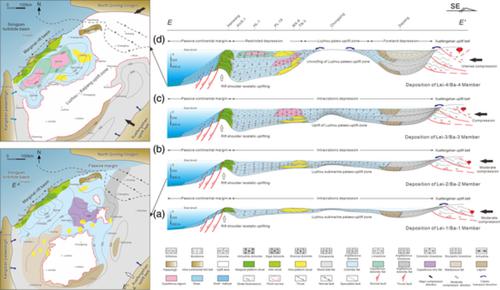当前位置:
X-MOL 学术
›
Geolog. J.
›
论文详情
Our official English website, www.x-mol.net, welcomes your
feedback! (Note: you will need to create a separate account there.)
Middle Triassic tectono‐sedimentary development of Sichuan Basin: Insights into the cratonic differentiation
Geological Journal ( IF 1.4 ) Pub Date : 2020-11-18 , DOI: 10.1002/gj.4033 Yingqiang Li 1, 2 , Shuangjian Li 1, 2 , Dengfa He 3 , Jian Gao 1, 2 , Yuanchong Wang 4 , Hanyu Huang 3 , Juntao Zhang 1, 2 , Yong Zhang 2
Geological Journal ( IF 1.4 ) Pub Date : 2020-11-18 , DOI: 10.1002/gj.4033 Yingqiang Li 1, 2 , Shuangjian Li 1, 2 , Dengfa He 3 , Jian Gao 1, 2 , Yuanchong Wang 4 , Hanyu Huang 3 , Juntao Zhang 1, 2 , Yong Zhang 2
Affiliation

|
The Middle Triassic succession of the Sichuan Basin contains key information about the Early Indosinian Movement, during which it has changed from extensional to compressional. In order to clarify the relationship between the evolution of the Sichuan Basin during the Indosinian Movement, the Middle Triassic tectonostratigraphic environment should be determined. Detailed stratigraphy and facies analysis integrated with structural and basin analysis, allowed a full reconstruction of the tectonic and depositional environments for the Middle Triassic strata of the Sichuan Basin. Six facies associations from two rock systems of: (a) carbonate–evaporite system and (b) a mixed carbonate–siliciclastic system, were characterized. Four depositional stages highlighted by the lithostratigraphic members of the Leikoupo (Lei) and Badong (Ba) formations were divided: (a) stable subsidence and deposition of the Lei‐1/Ba‐1 Member, leading to an embryonic ‘uplifts and sags’ configuration; (b) inherited deposition of the Lei‐2/Ba‐2 Member, with the platform margin belt extended; (c) rapid deposition of the Lei‐3/Ba‐3 Member, characterized by an eastward shift of the depositional centre and formation of the central anhydrite‐rich lagoon; and (d) intensification of cratonic tectono‐sedimentary differentiation during the Lei‐4/Ba‐4 deposition, that resulted in subaerial exposure along the Luzhou–Kaijiang uplift zone and a hydrodynamically restricted depression along the western platform. The Middle Triassic tectonic framework of the Sichuan Basin was dominated by compression in the east and extension in the west. The western margin was a passive continental margin, inheriting an early rifting event, while the eastern area within the craton showed an ‘uplift‐sag’ pattern, which is a response to intracontinental tectonic movement of the Xuefengshan uplift belt. The basin evolved from incipient low‐relief uplifts and sags within the intracratonic depression to subsequent isolated foreland and restricted depression during the Middle Triassic.
中文翻译:

四川盆地中三叠世构造-沉积发育:对克拉通差异的认识
四川盆地的中三叠世演替包含有关早期印支运动的重要信息,在此期间,它已从伸展运动转变为受压运动。为了阐明印支运动时期四川盆地演化之间的关系,应确定中三叠世构造地层环境。详细的地层和相分析与结构和盆地分析相结合,使四川盆地中三叠世地层的构造和沉积环境得以全面重建。表征了两个岩石系统的六个相联系:(a)碳酸盐-蒸发岩系统和(b)混合碳酸盐-硅质碎屑系统。以雷口坡(Lei)和巴东(Ba)地层的岩石地层学成员为重点的四个沉积阶段被划分为:(a)Lei-1 / Ba-1成员的稳定沉降和沉积,导致了胚胎的“隆起和下陷”配置; (b)继承了Lei-2 / Ba-2成员的沉积,并扩展了平台边缘带;(c)Lei-3 / Ba-3成员的快速沉积,其特征是沉积中心向东移动,并形成了富含硬石膏的泻湖;(d)在Lei-4 / Ba-4沉积期间克拉通构造-沉积的分化加剧,这导致沿zhou州-开江隆起带暴露于地下,并在西部平台上形成了受水动力限制的depression陷。四川盆地中三叠世构造框架以东部受压和西部向伸展为主。西部边缘是被动的大陆边缘,继承了早期的裂谷事件,而克拉通内部的东部地区呈现出“隆升—凹陷”模式,这是对雪峰山隆升带的陆内构造运动的一种反应。该盆地从克拉通凹陷内的初期低起伏隆起和下陷演化为中三叠纪随后的孤立前陆和受限凹陷。
更新日期:2020-11-18
中文翻译:

四川盆地中三叠世构造-沉积发育:对克拉通差异的认识
四川盆地的中三叠世演替包含有关早期印支运动的重要信息,在此期间,它已从伸展运动转变为受压运动。为了阐明印支运动时期四川盆地演化之间的关系,应确定中三叠世构造地层环境。详细的地层和相分析与结构和盆地分析相结合,使四川盆地中三叠世地层的构造和沉积环境得以全面重建。表征了两个岩石系统的六个相联系:(a)碳酸盐-蒸发岩系统和(b)混合碳酸盐-硅质碎屑系统。以雷口坡(Lei)和巴东(Ba)地层的岩石地层学成员为重点的四个沉积阶段被划分为:(a)Lei-1 / Ba-1成员的稳定沉降和沉积,导致了胚胎的“隆起和下陷”配置; (b)继承了Lei-2 / Ba-2成员的沉积,并扩展了平台边缘带;(c)Lei-3 / Ba-3成员的快速沉积,其特征是沉积中心向东移动,并形成了富含硬石膏的泻湖;(d)在Lei-4 / Ba-4沉积期间克拉通构造-沉积的分化加剧,这导致沿zhou州-开江隆起带暴露于地下,并在西部平台上形成了受水动力限制的depression陷。四川盆地中三叠世构造框架以东部受压和西部向伸展为主。西部边缘是被动的大陆边缘,继承了早期的裂谷事件,而克拉通内部的东部地区呈现出“隆升—凹陷”模式,这是对雪峰山隆升带的陆内构造运动的一种反应。该盆地从克拉通凹陷内的初期低起伏隆起和下陷演化为中三叠纪随后的孤立前陆和受限凹陷。











































 京公网安备 11010802027423号
京公网安备 11010802027423号